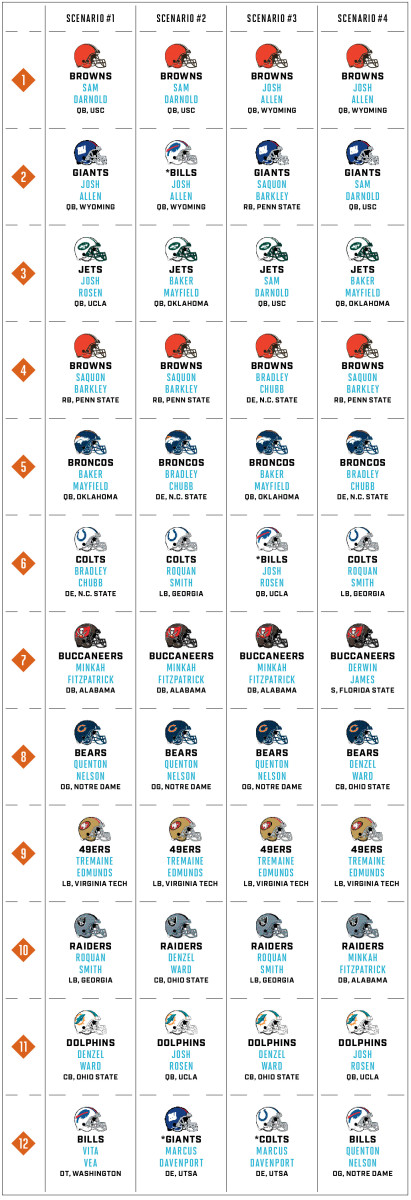NFL Mock Draft: A Realistic Look at How Teams Prepare for the NFL Draft

What you’re about to see is a tad unusual. We’re comparing four different scenarios of how the top 12 picks in the NFL draft might unfold—essentially, four mock drafts of the top 12 picks. This is the kind of exercise that will go on in draft rooms all over the NFL, so let me explain to you why it’s important and why teams around the league all do this in some form, using the New York Giants’ 1996 draft room as an example.
In 1996, the Giants had the fifth pick in the draft, with the Jets, Jaguars, Cardinals and Ravens picking one through four that year. A scout on that Giants’ staff, Greg Gabriel, recalls that New York had Keyshawn Johnson, Kevin Hardy, Simeon Rice and Jonathan Ogden in some order as their top four players. Sure enough, Johnson, Hardy, Rice and Ogden ended up going 1, 2, 3 and 4. The Giants entered the draft certain that Nebraska running back Lawrence Phillips would be picked somewhere in the top four, and perhaps even wideout Terry Glenn or tackle Willie Anderson. But no: When the first four picks were taken, as Gabriel tells the story, the Giants were stuck.
“There wasn’t a plan for all four to be gone,” Gabriel, a veteran scout now working as an NFL analyst for Pro Football Weekly and 670 The Score in Chicago. “We were on the clock and didn’t have a player we really liked, so George got on the phone and tried to trade down, and we just couldn’t get a good offer.” The Giants ended up picking defensive end Cedric Jones from Oklahoma. He went sackless in his first 28 NFL games and was a near-bust in five NFL seasons.
Said Gabriel: “I learned more from that draft than from anything: You gotta be prepared for the worst.”
In these final days of draft prep, teams are working through several draft-day forecasts to avoid these types of situations. Last year, the 49ers were picking second and wanted to choose Stanford defensive lineman Solomon Thomas. The Bears, picking third, wanted to trade up to two but wouldn’t tell the Niners who their man was. In the Niners’ offices, they’d heard the Browns would likely take Myles Garrett but GM John Lynch’s buddy, Denver GM John Elway told him the day before the draft, “Watch out for Mitch Trubisky with the Browns.” They traded from two to three with Chicago, at the risk of losing their preferred guy, Thomas.
First pick: Garrett. Second pick: Trubisky. San Francisco got their guy.
Late that night, Lynch told me, “Sometimes you see ghosts. You can never be sure, as long as we’ve studied it and all the people we know around the league, that you’ve got the right info about the picks in front of you. You gotta be prepared for anything.”
Thus, this exercise. Every team in the days before the draft will be working through various scenarios, ready for all alternatives. They don’t want the Cedric Jones situation to happen to them.
(In the below graphic, a star indicates a trade.)


The Browns may take Sam Darnold. They may take Josh Allen. They may take another quarterback. Regardless, most teams view this draft as starting with the second pick—where the trade market will be set in motion and the demand for the remaining quarterbacks will increase.
If the Giants take, say, Allen or Darnold, then we’ll have quarterbacks going 1-2-3. And then the pressure is on the Buffalos and Arizonas of the world (maybe Miami too?) to deal up because only one of the Big 4 QBs will be left for the taking.
If the Giants trade the pick to Buffalo or Arizona or Miami, then you’ll have, again, quarterbacks going 1-2-3, but one suitor will be taken out of the mix. And that means, for the quarterback-needy teams, it goes from a Black Friday-rush for the last one to a game of poker—When’s the right time to make your move for one, and what are the intentions of the other clubs?
And if the Giants take Saquon Barkley at 2? Then, you could have a quarterback or two slide—My guess, right now, would be that Josh Rosen is most likely to fall a little bit if that scenario plays out. Rumors on what new GM Dave Gettleman will do are all over the place right now, but we do know now that he has a lot of control over things will play out, a pretty good spot in which to be.
On the other side of the coin, you’ve got Denver at No. 5, motivated to deal out if their quarterback isn’t there; and Indianapolis with the No. 6 pick, open to dealing down. And both looking at a draft class that drops off in quality in the teens, which, I believe, very limits how the Colts (and maybe the Broncos too) would be willing to go back.
So the story of this draft? It’s not a great class. But with four quarterbacks in play in the top 10, it’s more interesting than most. Add all of the above to a league full of teams that have shown an increasing willingness to trade assets this offseason, and it sure looks like April 26 will be a fun night in Arlington, Texas.
